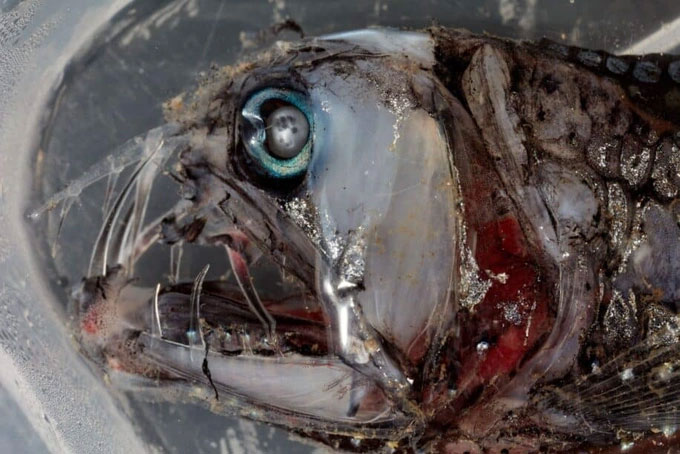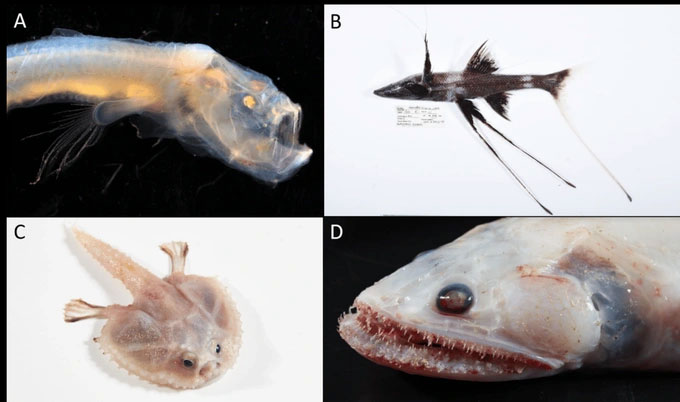Scary strange creatures discovered in Australian waters
Scientists have recently discovered terrifying, ghostly creatures living in the deep sea in Australia, where environmental conditions are harsh.
In October 2022, a team of explorers from the Museums Victoria Research Institute, Australia, undertook a revolutionary expedition into the deep seas of the Indian Ocean.

A species of lizard fish with long, sharp teeth was discovered for the first time during a recent expedition. (Photo: Museums Victoria).
After 35 days and a total distance of over 11,000km, the research vessel Investigator operated by the Australian National Science Agency has collected information about many species. In particular, there are species that have never been known before.
Life in these deep-sea areas is difficult for species due to the lack of light and scarcity of prey, but they can all adapt.
"These creatures have the ability to bioluminescent to attract prey, and at the same time hide or camouflage themselves at the depths of the sea. Among them, some have evolved with large mouths and scary teeth," Dianne Bray, senior director of Museums Victoria , told the press.
Among the new discoveries is a species that the explorers call the "Batfish" that can walk on the sea floor with two arm-shaped fins along with a fake "bait" placed in a small hole on its snout to attract prey.

A: A blind eel with transparent skin; B: A Tribute Spiderfish with stilt-like lower fins; C: A Batfish with fins resembling human hands; D: A Lizardfish with sharp teeth. (Photo: Museums Victoria).
In addition, there is the Tribute Spiderfish with extremely long lower fins that resemble stilts or the High-Winged Lizardfish with long, sharp teeth. They are both hermaphrodites .
Remarkably, this new species of lizardfish possesses giant fangs that can be seen even when its mouth is closed, and there is a glowing organ under its mouth that helps attract prey.
Meanwhile, the blind eel (with poorly developed eyes), which exists in an area about 4km below the sea surface, has a rectangular tail, can be up to a meter long but weighs only 50 grams.
In addition, blind eels also have curved jaws, always open and covered with hook-shaped teeth to search for food such as crustaceans.
Finally, scientists have discovered a new species of sea urchin, with a flat, crepe-like skeleton and poisonous spines.
According to UNESCO, the five major ocean basins including the Pacific, Atlantic, Indian, Arctic and Southern Oceans contain 94% of the world's wildlife and 97% of its total water.
Because the depths of the ocean abysses are largely unexplored, there are still many strange creatures that have not been discovered by science.
It should be noted that these undersea mountains are mainly of Upper Cretaceous origin - 65 to 80 million years ago - and may have been inhabited by human communities in the past.
The marine habitats of seamounts are also vulnerable to human activities, and this trip aims to collect important data for their conservation and management.
- Discovering marine creatures with extremely strange and scary shapes
- Discovered a strange mushroom creature off Australia
- Dozens of strange creatures found in Indonesia
- Canada: Discover many strange sea creatures
- Discover hundreds of strange creatures in the seabed of the Philippines
- Detecting a monstrous non-surface creature in the deep sea
- Colorful strange creatures wash up on the beach after heavy rain
- Strange creatures cross their heads on the Australian river
- Strange creatures like human blades washed ashore on Australia
- 'Strange' creatures discovered in 2019
- The most terrifying waters in the world
- Strange sea creatures in Antarctica
 Surprised: Fish that live in the dark ocean still see colors
Surprised: Fish that live in the dark ocean still see colors Japan suddenly caught the creature that caused the earthquake in the legend
Japan suddenly caught the creature that caused the earthquake in the legend A series of gray whale carcasses washed ashore on California's coast
A series of gray whale carcasses washed ashore on California's coast Compare the size of shark species in the world
Compare the size of shark species in the world